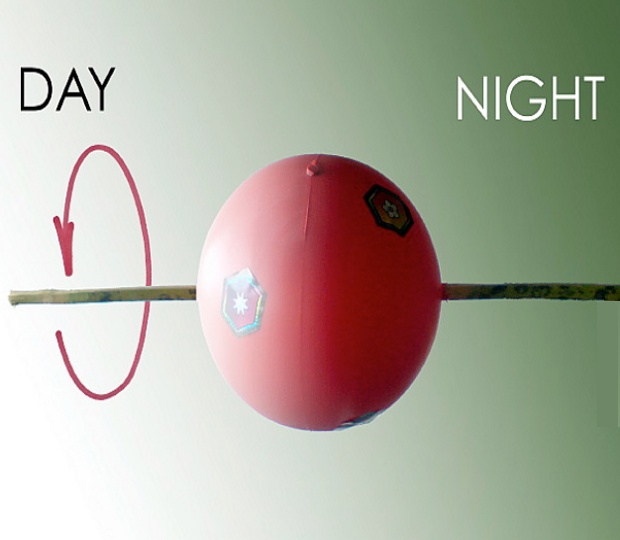In this activity, understand the rotation of the Earth in relation to the Sun, i.e. day and night. This activity is a fun dialogue with children. Elements of surprise and apparent contradictions stimulate their thinking.
Spinning Day and Night
 Brief Description
Brief Description Materials
Materials- Ball
- Stick
- Torch
 Learning Objectives
Learning Objectives-
Understand the rotation of the Earth in relation to the Sun
-
Use the idea of the Earth’s rotation to understand day and night and the apparent movement of the Sun across the sky
 Background Information
Background InformationThe Earth revolves around the Sun in a fixed orbit, a journey that takes exactly 365.26 days to complete (or as we know it, a year), it also rotates around its own axis.
The spinning of the Earth around its own axis causes day and night. It takes 23.93 hours to complete one rotation. The Earth completes one full rotation every 24 hours. This is why the Sun appears to rise in the East and set in the West. This motion creates day and night approximately every 12 hours. The Earth is spherical and at any given time, the half facing the Sun will be shined upon, while the other half will have no light. Places in the former will therefore experience day while places in the latter will experience night. The Earth spins anticlockwise as seen from space with North being up.
The cycle of night and day is continuous, except near the North and South Pole. If the Earth’s axis was perpendicular to its orbital plane, all places on Earth would experience equal amounts of day and night: 12 hours of day and 12 hours of night. However, the Earth’s axis is actually tilted at an angle of 23.4°. This means that during the Northern Hemisphere's summer, the North Pole always faces the Sun, so the sun doesn't set here and for several weeks it is continuous daytime. At the same time, the South Pole faces away from the Sun (Southern Hemisphere winter) and is in continuous night.
 Full Activity Description
Full Activity DescriptionStep 1
Pierce the ball with the stick, then hold them up and, using either a torch or daylight (e.g. through a window) for the Sun, demonstrate day and night to the children. The side of the ball in the light represents the side of the Earth experiencing daytime, the side in shadow demonstrates night-time. (Image 1)

Step 2
Identify or mark a spot on the ball. Spin the stick slowly so that the mark goes from shadow to light to shadow to light. Explain to the children that the Earth spins in this way as it travels around the Sun, which is why we see the Sun move across the sky, and experience day and night.
Step 3
Chose a point close to the top of the ball. Point the stick horizontally towards the light source, spin it slowly again and ask the students to watch the spot. (Images 2)

Step 4
Ask the children if there is still day and night at the spot. The children should say 'no', this spot on the ball experiences eternal daytime. (Although you can point out that the other side of the ball is experiencing night.)
Step 5
Explain that the Earth’s spins on an axis that is actually tilted at an angle of 23.4°. This means that during the Northern Hemisphere's summer, like the spot, the North Pole always faces the Sun, so the sun doesn't set here and for several weeks it is continuous daytime. At the same time, the South Pole faces away from the Sun (Southern Hemisphere winter) and is in continuous night.
 Additional Information
Additional InformationExtension
This game can be part of a larger set of activities that is used to explain the tilt of the rotation axis and the seasons. The main aspect of this activity is that it is an entertaining dialogue.
For more information and images see:
http://en.wikipedia.org/wiki/Earth's_rotation
http://en.wikipedia.org/wiki/Daytime_(astronomy)



 Keywords
Keywords Connection to National Curriculum
Connection to National Curriculum License
License Attachments
Attachments Downloads
Downloads


